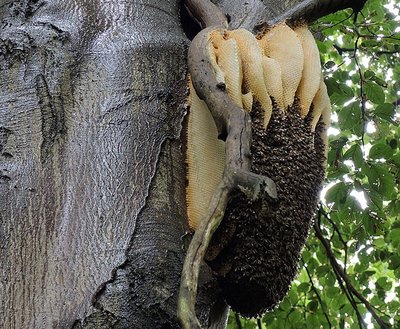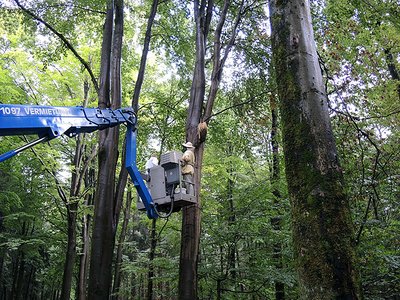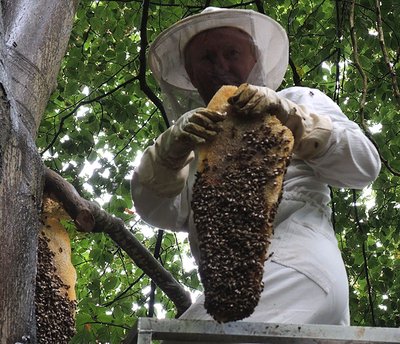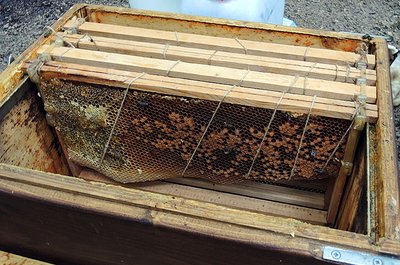What’s that buzzing sound? Our forest visitor hesitates. He has never heard a sound like this one before on his walks here in the forest. He looks around carefully, peers into the forest in an effort to discover what it might be - but to no avail. Then he puts his head back, looks steeply upwards into the trees, and blinks - there is something high up there after all. What he has discovered is something of a sensation. He looks more closely. At a height of around eight metres, he can see a large, brownish mass, dissected by strange-looking, yellowish slabs, hanging vertically. What can it be? He thinks for a moment, guesses correctly, and rings the local beekeepers’ association.
The beekeepers come equipped with everything you need to catch a swarm of bees. Given the height involved in this case, the lifting platform they bring with them is also very useful. Eventually, the air rescue operation is completed successfully and the swarm is re-housed in a beehive.
Bees - valuable insects
Honey bees play a major role in our ecosystem. We appreciate not only the honey they produce, but a whole series of other valuable bee products, many of which have healing properties. But even more important is the bees’ tremendous performance as pollinators: without bees, much of the indigenous plant world as we know it would be unthinkable. Bees generally feel themselves to be in good hands when being looked after by beekeepers. Beekeepers provide comfortable beehives of all sorts of different designs, and tailored to the bees’ needs. There are designated research institutes devoted to apiculture, and a multitude of associations ensuring high professional standards and good apicultural practice.
A bee swarm - multiplying by division
Bee breeders do not really want their protégés to get too bold. When the weather is pleasant and there is plenty of forage available, bees are wont to be overtaken by a feeling of confidence and adventurousness - the so-called swarm feeling. If permitted to do so, they will swarm. Half of the colony gathers around the queen bee, and then ten or twenty thousand bees appear to buzz wildly in apparent chaos around each other, making a tremendous noise.
It is not just the loss of their bees beekeepers are worried about when the bees swarm. The loss of bees does of course result in unwelcome losses in terms of the honey harvest. But what is far more dramatic is that a bee colony without a beekeeper faces certain death. This may sound like a piece of beekeepers’ propaganda, but on closer observation, it can unfortunately be confirmed. Bee expert Dr. Klaus Wallner of the University of Hohenheim explains: “Without appropriate housing, a swarm never comes to rest. The constant alertness saps the bees’ energy and prevents them from looking after their young properly and from building up adequate feed stores. During colder seasons, the skittishness of the bees may reduce the mass of bees to such an extent that the colony cannot maintain enough heat and eventually freezes to death.”
Even if the swarm succeeds in finding an appropriate new home, there is another deadly threat: the varroa mite. Completely unknown in Europe a few decades ago, it attacks vulnerable bees, bores through the adult bees’ carapace, and destroys the brood. If left untreated by the beekeeper, a colony of honey bees is thus doomed.
It may astound you to hear that bees that appear in a swarm, which may be very unnerving for some people, are in fact particularly docile at this time. Bees do in any case generally keep themselves to themselves, and are not interested in either people or their breakfast.
Industrious helpers for natural regeneration
Many plants are dependent on bees for pollination. This is well recognised in the agricultural and fruit-growing industries. Farmers and fruit-growers have long counted on insects to help pollinate the plants. Pollinating activity leads to a higher yield thanks to the larger number and heavier weight of the fruit. The quality of the fruit and the capability of the seed to germinate are also better if well pollinated. Most tree species are pollinated by wind, but some are dependent on insects, particularly many of the deciduous trees that are so important in times of climate change. As well as wild fruit trees such as the cherry, wild service tree (Sorbus torminalis), service tree (Sorbus domestica) and rowan/mountain ash, the bees seek out and exploit lime trees, maple, robinia, sweet chestnut and willow, thus also promoting their fruit formation. For these tree species it is thus also true to say that a lack of bees is detrimental for natural regeneration.
As with any generative propagation, fertilisation precedes natural regeneration. The more blossoms on a tree are fertilised, the more abundant the fruiting and dispersion of seed, and the more young trees are produced. The idea is that pollination leads to consistently larger seeds with a higher germination rate. This ensures on the one hand that the desired natural regeneration develops in the relevant stands. Secondly, it also allows the bees to become firmly established in seed collection stands. As far as natural regeneration and seed collection are concerned, it thus makes sense to use this and to focus on promoting pollination that is as intensive as possible. But how?
Forest owners could for example ask local beekeepers to place their beehives in their stands for as long as the trees are flowering. Professional pollination beekeepers position their beehives at regular intervals over the area for this purpose, thus ensuring with a high number of bees and colonies that the flowers are visited evenly and often.
Of apiculturists and bees
Apiculture in Germany: In Germany there are around 100.000 apiculturists, who look after some 750.000 bee colonies. A bee colony consists of up to 50.000 bees in high season. German beekeepers produce between 15.000 and 20.000 tonnes of honey each year. As the annual consumption of honey in Germany amounts to 85.000 tonnes, 80% of it has to be imported to cover requirements.
Pollination: Around 80 % of the 2.000 to 3.000 indigenous agricultural plants and wild plants depend on honey bees for pollination. The economic value of the bees’ pollinating activity exceeds the value of the honey produced by 10 to 15 times, amounting to around two (thousand million) billion Euros annually in Germany. The honey bee is thus the third most important working animal, after cattle and pigs.
Faithfulness to a flower: Bees are such good pollinators because they are “faithful” to a flower, i.e. they always seek out flowers of the same species. This ensures that the male pollen of the lime, for example, will always be carried to a female lime blossom.
Quantity: Efficient pollination through insects increases the number of fruit produced, as well as the size of the fruit, the number of seeds per fruit, the total yield, and the weight per thousand grains.
Quality: Pollination by insects has a positive effect on the shape, symmetry, firmness and storability of the fruit, the time of ripening, and the taste and sugar and acid content.
Honey yield: Under optimum conditions (weather, availability of water), the honey yield of one hectare of robinia can be as much as 1.000 kg. For lime it is between 150 and 600 kg/ha. By comparison, the quantity of blossom honey collected from a hectare of oil seed rape is 40-230 kg/ha, and from a field of cornflowers it is around 350 - 600 kg/ha.




